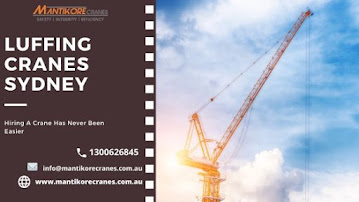Ensuring safety with the help of luffing cranes Sydney
The downtime from the repairs, preventing the damage of the cranes, and keeping your employees and bystanders safe at all times are all included in the mobile crane safety program of luffing cranes Sydney.
When the
machinery comes into contact with a power source such as the overhead power
lines or in operation, almost half of the mobile crane accidents occur. When a
crane moves materials near the energized power lines, and the hoist line or the
boom touch one is when it happens. In this time, the crane operator or a team
member on the low levels can be electrocuted.
It is the type of accident with electrical hazards can be eliminated
by having a pre-job mobile crane safety plan and a checklist. To assist in
determining whether the machinery will go under power lines at the site or route
to the site and whether they are energized or not can be ensured with the crane
operators. It all needs to be done before starting the job or travelling to the
site when you have the power company that de-energizes the lines can solve
this.
Using a lift plan
The typical kinds
of mobile crane accidents are overturned and loss of load. Exceeding the load
chart limits or improper rigging are the root causes here. Never try exceeding
the maximum load capacity guidelines for the lift's configuration to prevent
these kinds of crane accidents. So that the load is secured and balanced,
properly centre all loads and place the slings. You can use the taglines to
control the swing and rotation of the load if required.
A list of the
items have to be moved, including the description of each item's weight,
dimensions, and centre of gravity is what a good lift plan includes. The presence
of any hazardous materials, precautions, and the safety measures, the rigging
to use are all noted.
Be Alert for High Wind
For unexpected
changes, you need to monitor weather conditions. If there is inclement weather
of any type is expected or noticed nearby as you cease operations immediately.
Use of the On-the-Ground Spotters
In order to
ensure that the crane, load line, and the load itself is not colliding with the
other objects such as the signs, buildings, or machinery or come in contact
with power lines, all crane operators should have the spotters for this. If the
machinery will be fitting and operate in an area without interfering with
another object with spotters with a different line of vision.
Avoid Two-Blocking
It is due to
two-blocking that many mobile crane accidents take place. The crane's boom
nose, auxiliary nose, or the nose of a boom extension are unsafe conditions
where the load block or auxiliary ball comes into contact. It can have its boom
and attachment that is pulled over backward with a lattice boom crane.
Extending the
boom or hoisting up with the help of two-blocking that can occur while lowering
the boom. To avoid these situations, the crane operator and the spotter should
be constantly aware of where the load block and the auxiliary ball is about the
boom or the boom extension.



Comments
Post a Comment